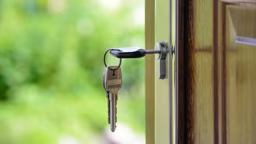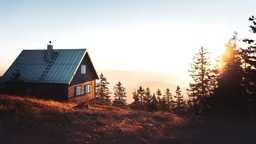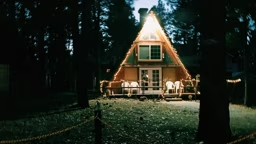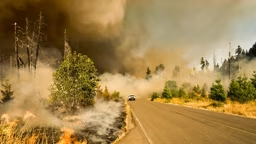“Hotter” and “faster.” These are familiar words if you’re a cabin dweller anticipating a soothing dip in a hot tub. In recent years, however, those words have developed a different connotation and evoked a different set of emotions: those of fear and devastation.
Wildfires. They burn hot. They burn fast. And each year, they destroy or damage hundreds of cabins, as well as year-round homes. While living safely in the woods used to simply mean protecting yourself against skunks, biting flies and mosquitoes, woodland living and the desire to move back to nature now bestows upon homeowners the responsibility of protecting family and structures from the danger of wildfire.
The Wild/Urban What?
The areas cabin owners choose for their getaways are generally some of the most beautiful in the country and often are the gemstones of our nation’s forests. They are special places – nestled into the pineries of Minnesota, the chestnut oaks and eastern hemlocks of New York, the junipers of Texas or within the mixed conifer forests of California.
These areas are so special that they’ve been collectively labeled with a unique name: the wildland/urban interface. These are places where people and their development sprawl into wild habitat.
These are also the places where your chances of losing everything you have – including life – is greater than most any other place you may have chosen to live or recreate.
In many areas, the wildland/urban interface is becoming a suburb of sorts. And when homes blend together with wild lands, this blend creates new challenges to safe living. More specifically, this blend interrupts the natural cycle of wildfire, ultimately contributing to a dangerous build-up of old vegetation and potentially leading to an uncontrollable wildfire.
Wildfires. They burn hot. They burn fast. And each year, they destroy or damage hundreds of cabins, as well as year-round homes. While living safely in the woods used to simply mean protecting yourself against skunks, biting flies and mosquitoes, woodland living and the desire to move back to nature now bestows upon homeowners the responsibility of protecting family and structures from the danger of wildfire.
The Wild/Urban What?
The areas cabin owners choose for their getaways are generally some of the most beautiful in the country and often are the gemstones of our nation’s forests. They are special places – nestled into the pineries of Minnesota, the chestnut oaks and eastern hemlocks of New York, the junipers of Texas or within the mixed conifer forests of California.
These areas are so special that they’ve been collectively labeled with a unique name: the wildland/urban interface. These are places where people and their development sprawl into wild habitat.
These are also the places where your chances of losing everything you have – including life – is greater than most any other place you may have chosen to live or recreate.
In many areas, the wildland/urban interface is becoming a suburb of sorts. And when homes blend together with wild lands, this blend creates new challenges to safe living. More specifically, this blend interrupts the natural cycle of wildfire, ultimately contributing to a dangerous build-up of old vegetation and potentially leading to an uncontrollable wildfire.
Starve a Fire, Save a Cabin
Regrettably, existing firefighting resources in these areas – including rural fire departments and volunteer firefighters – are less able to protect everyone’s property while they focus on controlling the wildfires themselves.
Whether you live and recreate among the pines or the junipers of this nation, wildfires grow in direct proportion to how much they are fed. So one way to think about preventing a fire – or killing it before it happens, is to think about starving it.
A wildland fire does not spread to a home unless the home meets the fuel and heat requirements necessary for ignition and continued combustion. So if you take proactive steps to reduce the likelihood of home ignition during a wildfire, you have a far greater chance of having your cabin survive.
Certain materials are much less vulnerable to a fire than others. Heat- and flame-resistant construction materials, for instance, can be used to build homes, decks, garages, porches and fences. The most protective roofing materials will be rated “Class-A,” and that includes asphalt shingles and metal, cement and concrete products.
For already-established residents, there are plenty of other menu choices. Residents can reduce the risk of their home’s ignition by simply modifying their homes and immediate surroundings by clearing a space around the home. Steps as simple as cleaning gutters and eaves of leaves and debris can prevent an ember from igniting a home.
What You Can Do
The following are easily doable for most homeowners in wildland/urban interface areas:
• Keep 100 feet of garden hose attached to your home.
• Keep your chimney clean and install a spark arrester.
• Keep your roof clear of leaves, needles and other debris.
• Clear dead and dense vegetation within 30 feet of structures.
• Prune tree branches up to 6 to 10 feet from the ground.
• Avoid outdoor burning; recycle mulch and compost whenever possible.
• Keep your woodpile 25 feet from structures and fuel tanks.
• Keep your grass green and mowed 100 feet from any structure.
• Remove burnable materials from under and around all structures.
• Keep driveways accessible for fire trucks; provide a turnaround area.
Regrettably, existing firefighting resources in these areas – including rural fire departments and volunteer firefighters – are less able to protect everyone’s property while they focus on controlling the wildfires themselves.
Whether you live and recreate among the pines or the junipers of this nation, wildfires grow in direct proportion to how much they are fed. So one way to think about preventing a fire – or killing it before it happens, is to think about starving it.
A wildland fire does not spread to a home unless the home meets the fuel and heat requirements necessary for ignition and continued combustion. So if you take proactive steps to reduce the likelihood of home ignition during a wildfire, you have a far greater chance of having your cabin survive.
Certain materials are much less vulnerable to a fire than others. Heat- and flame-resistant construction materials, for instance, can be used to build homes, decks, garages, porches and fences. The most protective roofing materials will be rated “Class-A,” and that includes asphalt shingles and metal, cement and concrete products.
For already-established residents, there are plenty of other menu choices. Residents can reduce the risk of their home’s ignition by simply modifying their homes and immediate surroundings by clearing a space around the home. Steps as simple as cleaning gutters and eaves of leaves and debris can prevent an ember from igniting a home.
What You Can Do
The following are easily doable for most homeowners in wildland/urban interface areas:
• Keep 100 feet of garden hose attached to your home.
• Keep your chimney clean and install a spark arrester.
• Keep your roof clear of leaves, needles and other debris.
• Clear dead and dense vegetation within 30 feet of structures.
• Prune tree branches up to 6 to 10 feet from the ground.
• Avoid outdoor burning; recycle mulch and compost whenever possible.
• Keep your woodpile 25 feet from structures and fuel tanks.
• Keep your grass green and mowed 100 feet from any structure.
• Remove burnable materials from under and around all structures.
• Keep driveways accessible for fire trucks; provide a turnaround area.
Strength in Numbers
A national tool has been designed to assist communities and individuals across the nation with meeting the wildfire threat. Its name is “Firewise.” The foundation of the program lies in providing a simple framework by which citizens of a community can work together to prevent their properties from becoming fuel for a wildfire.
If you’ve noticed that your lake or land association meetings don’t include a discussion of Firewise tactics, maybe you can encourage your association president to add this topic to the next meeting agenda. You might also share some of the following success stories.
In Minnesota’s Itasca County, citizens have tailored the national program to meet the local needs and energies of its own citizens. The program encourages citizens to clean up debris, leaves, needles and brush around their homes. Woody vegetation is collected and taken to the Minnesota Power Rapids Energy Center for use in renewable energy programs and facilities.
New York’s Shawangunk Ridge is home of the rare ridgetop dwarf pitch pine barrens and supports the second largest chestnut oak forest. Many highly flammable plant species exist around the local community of Cragsmoor.
A Firewise Board was formed, comprised of individuals from several community groups ranging from The Nature Conservancy to the Cragsmoor Volunteer Fire Company. Its members adopted a mission: To identify and raise awareness of the potential for property damage, personal injury or loss of life in the event of a wildfire in the hamlet of Cragsmoor; and to implement strategies to minimize the impact wildfires will have on the lives and property of Cragsmoor residents.
The Wildcatter Ranch and Resort in Young County, Texas, took a proactive approach to building and living in the Texas summers among its tinder dry junipers. While the 1,500-acre ranch was initially under development, the ranch planned and/or executed the following:
• Removed a strip of juniper trees 100 feet below the hilltop.
• Constructed sprinkler systems according to Firewise specs.
• Erected a 10,000-gallon storage tank with backup pump.
• Installed dry hydrants (a non-pressurized pipe system permanently placed in existing ponds or streams that provide a suction supply of water to a fire department tank truck).
• Spaced buildings a minimum of 100 feet apart.
• Made sure that in dry weather, grass will be grazed or mowed.
• Developed an excellent all-weather road system.
Fifty miles east of Sacramento lies Grizzly Flats, California – a place where steep topography and natural fuels abound, making the flats very vulnerable to wildfire. It’s also the place where the Grizzly Park subdivision has grown. A Grizzly Flats Fires Safe Council was formed. One of its first activities was to identify viable evacuation routes in the event of a disaster. Packets that contained evacuation route maps, information on the Council, brush chipping programs, Community Emergency Response Team recruitment and medical history forms were distributed to every homeowner within Grizzly Flats. The information was put into a magnetic folder that could be placed on the refrigerator and retrieved quickly during an emergency.
In closing, continue to live richly within your northern pineries and within the arms of the oaks. But balance the equation with a safe lifestyle and a firewise home.
Writer Kathleen Preece traverses the wildland/urban interface, seeking to tell the stories of the Midwest’s natural resources.
A national tool has been designed to assist communities and individuals across the nation with meeting the wildfire threat. Its name is “Firewise.” The foundation of the program lies in providing a simple framework by which citizens of a community can work together to prevent their properties from becoming fuel for a wildfire.
If you’ve noticed that your lake or land association meetings don’t include a discussion of Firewise tactics, maybe you can encourage your association president to add this topic to the next meeting agenda. You might also share some of the following success stories.
In Minnesota’s Itasca County, citizens have tailored the national program to meet the local needs and energies of its own citizens. The program encourages citizens to clean up debris, leaves, needles and brush around their homes. Woody vegetation is collected and taken to the Minnesota Power Rapids Energy Center for use in renewable energy programs and facilities.
New York’s Shawangunk Ridge is home of the rare ridgetop dwarf pitch pine barrens and supports the second largest chestnut oak forest. Many highly flammable plant species exist around the local community of Cragsmoor.
A Firewise Board was formed, comprised of individuals from several community groups ranging from The Nature Conservancy to the Cragsmoor Volunteer Fire Company. Its members adopted a mission: To identify and raise awareness of the potential for property damage, personal injury or loss of life in the event of a wildfire in the hamlet of Cragsmoor; and to implement strategies to minimize the impact wildfires will have on the lives and property of Cragsmoor residents.
The Wildcatter Ranch and Resort in Young County, Texas, took a proactive approach to building and living in the Texas summers among its tinder dry junipers. While the 1,500-acre ranch was initially under development, the ranch planned and/or executed the following:
• Removed a strip of juniper trees 100 feet below the hilltop.
• Constructed sprinkler systems according to Firewise specs.
• Erected a 10,000-gallon storage tank with backup pump.
• Installed dry hydrants (a non-pressurized pipe system permanently placed in existing ponds or streams that provide a suction supply of water to a fire department tank truck).
• Spaced buildings a minimum of 100 feet apart.
• Made sure that in dry weather, grass will be grazed or mowed.
• Developed an excellent all-weather road system.
Fifty miles east of Sacramento lies Grizzly Flats, California – a place where steep topography and natural fuels abound, making the flats very vulnerable to wildfire. It’s also the place where the Grizzly Park subdivision has grown. A Grizzly Flats Fires Safe Council was formed. One of its first activities was to identify viable evacuation routes in the event of a disaster. Packets that contained evacuation route maps, information on the Council, brush chipping programs, Community Emergency Response Team recruitment and medical history forms were distributed to every homeowner within Grizzly Flats. The information was put into a magnetic folder that could be placed on the refrigerator and retrieved quickly during an emergency.
In closing, continue to live richly within your northern pineries and within the arms of the oaks. But balance the equation with a safe lifestyle and a firewise home.
Writer Kathleen Preece traverses the wildland/urban interface, seeking to tell the stories of the Midwest’s natural resources.
The Pain & Passion of a Disaster
The Ham Lake Fire of 2007
Mike Prom wears many hats. He’s a son, husband, father, business owner, and chief of the Gunflint Trail Volunteer Fire Department, located in the Arrowhead Region of northeastern Minnesota.
Mike found himself wearing those many hats, and more, during the Ham Lake Fire of 2007.
And when Mike stood in front of his parents’ cabin at the end of the Gunflint Trail on May 6, 2007, he was grief-struck. He looked at the home of his parents, Sid and Pat Prom, and wondered if that look would be his last.
His dad asked him if the cabin would survive; Mike responded: “I am hoping nobody dies.”
Mike and Sue Prom, owners and operators of Voyageur Canoe Outfitters, live and work year-round on the Gunflint. They are both firefighters. They are, as their business website depicts, people who have the “Spirit of the Voyageur” and believe strongly in “the kind of adventure where you become in tune with nature.”
As with so many who live, work and vacation in the Gunflint area, tuning in with nature that eventful year meant facing the largest forest fire in the region in at least a century.
Sue’s blog at the time rekindles the pain and the passion of the disaster: In case you didn’t know it, all entry points into the Boundary Waters via the Gunflint Trail are closed . . . It definitely isn’t business as usual on the Trail.
We’re still not sure when we will be able to go home. No power and no phones.
We drove up to Voyageur for a propane run yesterday, and my heart ached. The cabins that are missing, the trees that are scorched and the memories attached to all of my favorite places in the woods are heavy on my heart. I do consider us all lucky and can’t believe we were able to get people evacuated without any deaths.
I have heard the question so many times, “How are you?” This isn’t easy to answer. When we’re doing something to aggressively fight the fire, then we’re all okay. But if you give us any time to let our minds think about it, then we’re not.
I came to town last night to spend Mother’s Day with my kids. I was stopped at a roadblock, and by the time I got to them, they were in bed. I didn’t feel like talking. I just felt like crawling in between my kids on an air mattress and going to bed.
Sid and Pat’s cabin did survive. The fires burned close: An upper window cracked from the heat, bird feeders melted, and the propane tank heated to the point of releasing propane.
But a number of the defensible steps, taken in the planning and building of the cabin paid off, including: a steel roof, 30 feet of clearance around the cabin, no attached deck, closed soffits, screens in vents to prevent debris (i.e., fuel) from collecting and a cabin built right to the ground thereby eliminating the collection of fuels underneath.
At the end of May, Sue blogs: Out of the ashes emerge tons of new green each day. There are blue bead lilies, fiddlehead ferns and many other new plants; some of these are already over a foot tall. The re-growth of the forest is something we will be able to see and experience first hand because we live here. I never get tired of saying how lucky we feel to live in such a wonderful place.
By the time the Ham Lake Fire of 2007 was contained, it burned more than 75,000 acres, and it destroyed 140 structures on the Minnesota side worth millions of dollars.
The View From Here
The Yellowstone Fire of 1988
There are vantage points, and there are disadvantage points. Jim Sanders happened to be standing at the apex of both of them.
A long-time forest professional, Jim oversees sprawling woodlands. He has received the alarms for wildfires, directed the containment efforts, planned the cleanup and counted the seedlings for regeneration. He has listened to the horror stories, he has celebrated with survivors – and lived through his own wildfire horror.
In 1988, Jim experienced a fire from a dual perspective – both professional and personal. At the time, he was the division leader of one of the nation’s supreme natural wonders, Yellowstone National Park. The park met with catastrophe in 1988, when wildfires demanded the skills of more than 25,000 firefighters at a total cost of over $120 million. In the end, 793,000 acres (about 36 percent of the park) were burned and 67 structures were destroyed.
And the heat of the fires threatened Jim’s own family, his own home.
The images remain vivid in Jim’s mind. They include those of his wife, Pat, cataloging their belongings – the children’s toys, photos and their household keepsakes – as their two small children watched. It meant packing what was packable, leaving behind what could be abandoned, prepping minds and bodies to leave during the night.
“The Yellowstone Fires forever took wildland firefighting, risks, and issues and moved them from a professional context to a personal one,” Jim testifies.
“When you have experienced the act of cataloging the rooms in your home and the people in your heart, you can never ‘go back.’ You keep going – be it to face a Ham Lake Fire or another disaster that threatens the world as you know it.”
Editor’s Note: More recently, Jim Sanders also oversaw the Ham Lake Fire while he was the forest supervisor for another U.S. treasure, the Superior National Forest.
 dreamstime.com
dreamstime.com 
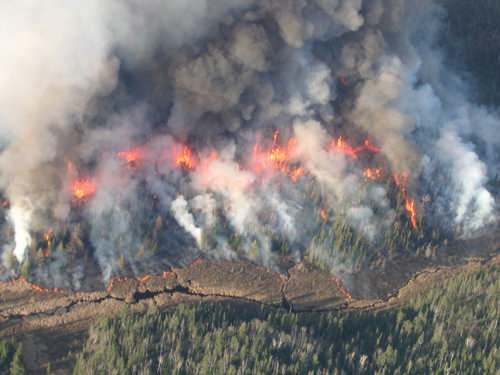 Cindy Lueth
Cindy Lueth 
 dreamstime.com
dreamstime.com 



